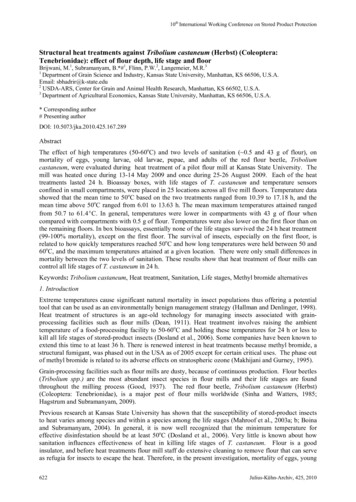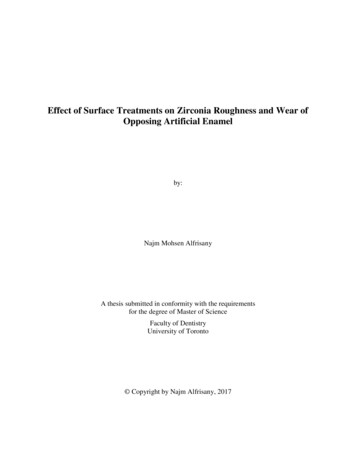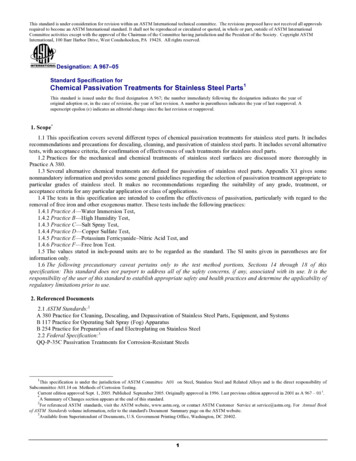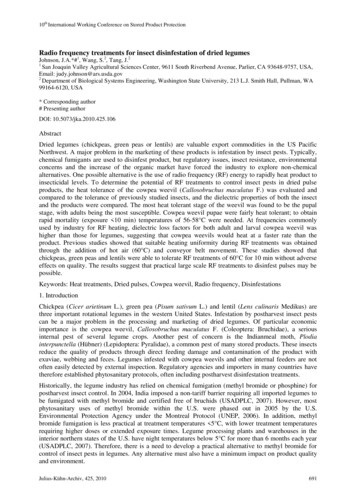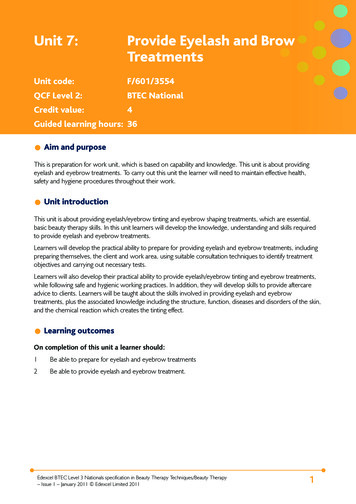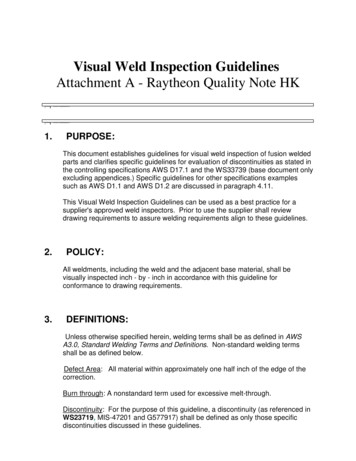
Transcription
Post Weld Heat Treatments forNew and In ServiceCoke Drums Paul Kovach - Stress Engineering Services Richard Boswell - Stress Engineering ServicesAugust 20091
Welding Issue When weld is applied it is molten metal andthermally expanded when filling a groove. When weld metal cools, it will shrink a lot. YieldStrength is low for much of the cooling range. Surrounding metal that was not heated to moltentemperatures will constrain or keep the weld fromshrinking as it cools. Internal forces and moments are self equilibratingto keep the weld and welded parts together whencold.August 20092
What is PWHT? Post Weld Heat Treatment is a procedure toreduce residual stress, temper the HAZ, andremove hydrogen from the weld region after aseam weld is made. Can be Global (entire vessel) or Can be Local (weld seam and surrounding metalonly) Weld and HAZ heated below the transitiontemperature for several hours and then graduallyallowed to cool.August 20093
Why PWHT ? PWHT requires reheating to allow weld metalto yield and comply with the distortions,forces, and moments previously trapped andheld by the weld. Likelihood of later cracking reduces with lowerresidual tension stress. Hydrogen gas is removed to prevent latercracking. At best, the residual tensile stress is reducedfrom yield to 1/3 of yield strength, but never tozero.August 20094
Issues for PWHT High temperature during PWHT and usage createslower yield stress in components :––––base metalweld metalweld capcladding Components have different yield strengths andthermal expansions Free expansion creates no stress Constrained expansion creates stress Non uniform temperatures creates constraintAugust 20095
Plate Component Yield StrengthsAugust 20096
ConceptualConstraint Model Outerbarsandtop/bottomplatesrepresent the cokedrum Inner bar representsweld metal, HAZ, andheated base metal Inner bar is heatedand constrained byouter bars, and yieldsin compression, Final result is residualtension stressAugust 20097
Local Repairs for In Service DrumsWRC Bulletin 452 (June 2000) Local Post Weld Heat Treatment is for repair of vesselsin service after fabrication. “For PWHT to be successful, it must be based rs to meet the desired objectives.” “As a result, engineering judgment, in addition to statedcode requirements, is often necessary.” See Welding Research Council Bulletin 452.August 20098
PWHT for OlderDrums in Service Coke Drums are Pressure Vessel Design Compliant, but arein cyclic service. Low Cycle Fatigue happens to coke drums, with basemetal and weld seam stressed beyond Nominal Yieldevery cycle. Cracks will eventually occur in all coke drums. Through Wall Cracks will allow contents to leak and theresult can be a fire during leakage or on the next cycle. Through Wall Cracking must be weld repaired as quicklyand efficiently as possible to restore production. After Weld Repair, a Local PWHT is often applied toremove hydrogen, temper the HAZ, and reduce theresidual stress. This can also be a global PWHT instead.August 20099
Temperature vs Time (ASME) Rate of heating and cooling specified. Maximum temperature specified. Testing of samples prior to PWHT will qualifythe procedures for the application. Soak time to represent fabrication sequenceand extra time for future repairs.August 200910
Temperature vs Length (WRC 452) Based upon the American Welding SocietyANSI/AWS D10.10-90, Recommended Practicesfor Local Heating of Welds in Piping and Tubing. Gradient Control Band– controls axial temperature gradient– minimizes heat losses– 8(Rt) 1/2 plus width of soak band Axial temperature gradient– control is important to limit thermal stress– protect vessel outside of band: “not harmful”– limit temperature to no less than 50% soak atdistance of 2(Rt)1/2 from edge of soak bandAugust 200911
PWHT of New or OldDrumonSiteGas Burners usedinside of aninsulated drumbuilt on site. Also used whenmany repairsmade at sametime in existingdrum. Concern forCollapse in skirt Not Commonlyperformed.August 200912
New Drum Construction PWHT All seams in a new drum must be PWHTbefore delivery The problem is that many new drum sizesno longer fit in fabrication furnaces, anddrums are PWHT in pieces to assure thelongitudinal seam receives full benefit as itis loaded in hoop stress by internal designpressure.August 200913
New DrumConstruction PWHT Once the Can Section pieces are PWHT they areassembled together and then exposed to anotherPWHT cycle. This is often performed with Local PWHTprocedures that comply with Pressure VesselCode specifications although the issues of WRC452 are not addressed. Consequently, some material of the drum nearthe seam being treated undergoes multiple PWHTcycles and material is damaged more thanintended.August 200914
New Drum Specifications Fabrication Specifications usually attempt to protect thedrum by requiring assurance that the material canundergo enough hours at PWHT temperature to addressrepeated cycles as well as possible repairs after manyyears of operation. This is required by ASME Section VIIIDiv 1 UCS-85 (c) for base material and in Section IX QW407.2 for the PQRs (where impact is required) The number of hours at PWHT temperatures is importantbecause of creep damage and material deterioration. It is important to assure the narrow range of the PWHT iscomplied with and not exceeded or not attained.August 200915
Conventional Coke Drum FabricationFeatures LPWHT The following slides depict a typical and traditionalcoke drum assembled using pressure vesselprocedures Smaller parts are sent to the stress relief furnace toassure the longitudinal seams are fully stressrelieved. Eventually the assembly is too large for the oven andthe Local PWHT are required. Final assembly is the Closure Seam with LPWHT.August 200916
1. Clad Plateis Prepared2. Clad Plateis Formed toDiameterAugust 200917
3. One or severalplates assembled intoa Cylindrical Can andmay be Furnace HeatTreated (Long.Seams)4. Cans are combinedand stress relieved infurnace as singles orpairs of cans (Long. andCirc seams)August 200918
5. Lower half of drumis assembled andbecomes too big forfurnace so LPWHT isused for connectingSeams6. Upper half of drumis assembled andbecomes too big forfurnace so LPWHT isused for connectingseamsAugust 200919
7. Twohalves readyfor ClosureSeam Weld8. Twohalves arejoinedtogetherAugust 200920
9. Closure seam is LPWHTThe vessel near thisseam has material thatsees 2 PWHT cyclesAugust 200921
Common Issues for PWHT and LPHWT Cans should be round and concentric when joined toreduce internal moments and forces. Supports required to maintain roundness. Supports must allow thermal expansions to preventbuckling during heating and cooling. Vessel must be supported to reduce bending andsagging. Maximum temperatures and duration must becontrolled.August 200922
Thank YouPaul Kovach - Stress Engineering ServicesPaul.Kovach@stress.comRichard Boswell - Stress Engineering ServicesRichard.Boswell@stress.comAugust 200923
SPAmangiarottiPressure Equipment for Oil, Gas and Chemical IndustryPost Weld Heat Treatments forCoke DrumsSince1930Copyright mangiarotti24- August 2009
mangiarotti – current PWHT capabilities (1)---Sedegliano (Headquarters) Inland Workshop :- single piece – one shot HT up to 22ft x 22ft x 86 ft- local HT (either by electric resistance, computer-controlled, 110 kW power– or with gas burners) with no size limits when the particularconstruction sequence requires so (e.g. : tubular reactors with duplextubes)San Giorgio di Nogaro Port Facility :- single piece – one shot HT up to 34ft x 34ft x 200 ft(*)- local HT as for Sedegliano WorkshopMilano Workshop :- single piece – one shot HT up to 26ft x 26ft x 72 ft- local HT by electric induction, 400 kW power(*) length virtually unlimited upon availability of panels to be fabricated on a case-by-case basisCopyright mangiarotti- August 200925
mangiarotti – current PWHT capabilities(2)Sedegliano(Inland Facility) Fixed FurnaceFixed furnace22ft x 22ft x 86ftCopyright mangiarotti- August 200926
mangiarotti – current PWHT capabilities(3)San Giorgio (Port Facility) Modular FurnaceSingle span (Small)17ft x 17ft x 400ftDouble span (Large)34ft x 34ft x 200ftCopyright mangiarotti- August 200927
mangiarotti – current PWHT capabilities(4)Milan Inland FacilityFixed furnace26ft x 26ft x 72ftCopyright mangiarotti- August 200928
mangiarotti – future PWHT capabilities-NMonfalcone Workshop currently under construction :- big new facility conceived and designed to ultra-modern fabricationstandards with specific emphasis to optimizing nuclear as well asconventional large/thick/heavy equipment fabrication- will replace Milano facility (which has a logistic limit being locatedclose to the city center)- scheduled and expected to be 100% up and running as of January, 2011PWHT capability :- single piece – one shot HT up to 38ft x 36ft x 98 ft- local HT facilities : see other facilitiesCopyright mangiarotti- August 200929
mangiarotti – future PWHT capabilities(4)at NEW Monfalcone Port FacilityModular furnace38ft x 36ft x 98ftDesign of the new large modular furnace under constructionCopyright mangiarotti- August 200930
Confused on mangiarotti facilitiesmangiarottilocations ? A quick re-cap SEDEGLIANOInland ShopSAN GIORGIOPort FacilityMILANO ShopMONFALCONEPort FacilityCopyright mangiarotti31- August 2009
Sometimes, amangiarottiLPWHT is unavoidable(1) When a specific fabrication sequence requires it, to avoid treating a part of theequipment (e.g. due to specific metallurgy not allowing heat treatment)In such cases, proper systems have to be set up for accurate heating, temperatureholding, and cooling down, without affecting areas of metal not to be HTCopyright mangiarotti- August 200932
Sometimes, amangiarottiLPWHT is unavoidable (2) but a perfectly controlled temperature cycle must be applied (example of our AECTechnology 380V 120kW computerized electric resistance LPWHT machine)Desired LPWHT cycle easily and preciselyacquired by the control softwareCopyright mangiarotti- August 2009Control system for electric resistance LPWHT33
Sometimes, amangiarottiLPWHT is unavoidable (3) Examples of LPWHT and ISR in Tubular Reactors / HP Heat Exchangers / HC Reactors :Automized electricLPWHTCopyright mangiarottiTangential Gas Burnersthermocouple controlledLPWHT- August 2009Local ISR with fixedtoroidal chamber furnaceand rotating equipmentfor optimal and steadyheat distribution alongcircumference andvertical axis34
Besides the stress issue, there is amangiarottimetallurgical problem with the LPWHTHollomon Parameter (HP) as an index ofHT “damage” (accounting for bothtemperature and time)Typical properties drop as aresult of higher HP (longerHT and/or higher T)Graphs are courtesy of Dillinger-Hütte GTSCopyright mangiarotti- August 200935
But, on Coke Drums LPWHT can bemangiarottiavoided as long as :– Suitable facilities are available (adequate furnace size andmodern automized control system)– The heat treatment is properly designed to achieveaccurate and reliable control of metal temperatures(rather than internal air temperature) well thought-outthermocouples distribution on piece– Supporting and / or reinforcement members are designedto control CD deformation and prevent permanentdistortions temporary removable internal & externalsteel structuresCopyright mangiarotti- August 200936
Single piece mangiarottiPWHT on Coke Drums(1)Theoretical thermaltransient simulation viaour proprietary softwareCopyright mangiarotti- August 2009Design of external supporting system for HT37
Single piece mangiarottiPWHT on Coke Drums(2)Design of internal temporary reinforcing bars for HTCopyright mangiarotti- August 200938
Single piece mangiarottiPWHT on Coke Drums(3)Precise temperature control with a suitable number of properly locatedthermocouples to drive the burners via a PLC systemCopyright mangiarotti- August 200939
One-shot PWHT integrated intomangiarotti“smart” fabrication processes (1) PWHT is critical, but it’s not the only fabrication issue which may affect residualstresses likely to be detrimental to CD life expectancyAn array of other fabrication facilities are complimentary to the achievement ofthe same goal : the minimization of stresses as a result of the entire fabricationprocess. Examples are : precise bevelling to “state-of-the-art” narrow gap design Copyright mangiarotti- August 200940
One-shot PWHT integrated intomangiarotti“smart” fabrication processes (2) PWHT is critical, but it’s not the only fabrication issue which may affect residualstresses likely to be detrimental to CD life expectancySpecial adjustable jigs for CD “petals” assembly to ensureperfect roundness without introducing stress risersCopyright mangiarotti- August 200941
Coke Drum Finished &Ready to Ship !FOB / Port Loading activitiesLarge Area for CD StorageCopyright mangiarotti- August 200942
Quick Mangiarotti OverviewCopyright mangiarotti- August 200943
heavy plate rollsPower 6200 Tons Width3600 mm X 300 mmCopyright mangiarotti- August 200944
machining departmentTwo large CNC Milling MachinesY 5000; X 18000; Z 1750 1500Top picture: Reactors shell belt in position fornozzles cut-outs (4900 mm ID & 263 mm thk).Side picture: Typical Inner machining onReactors shell body prior to internal installation(2800 mm ID & 50 8 mm thk of Weld Overlay)Copyright mangiarotti- August 200945
machining departmentVertical LatheCapabilities: 7500 mm Dia.; 4000 mm Height;130 Tons weight.Copyright mangiarotti- August 2009Boring MillCapabilities: 23000 mm Width; 7200 mm Height;300 Tons weight max.46
deep drilling (INNSE)with 3 spindlesHole Dia.: 32 mm max. (52 mm with single spindle)M
ANSI/AWS D10.10-90, Recommended Practices for Local Heating of Welds in Piping and Tubing. Gradient Control Band – controls axial temperature gradient – minimizes heat losses – 8(Rt) 1/2 plus width of soak band Axial temperature gradient – control is important to limit thermal stress – protect vessel outside of band: “not harmful”

